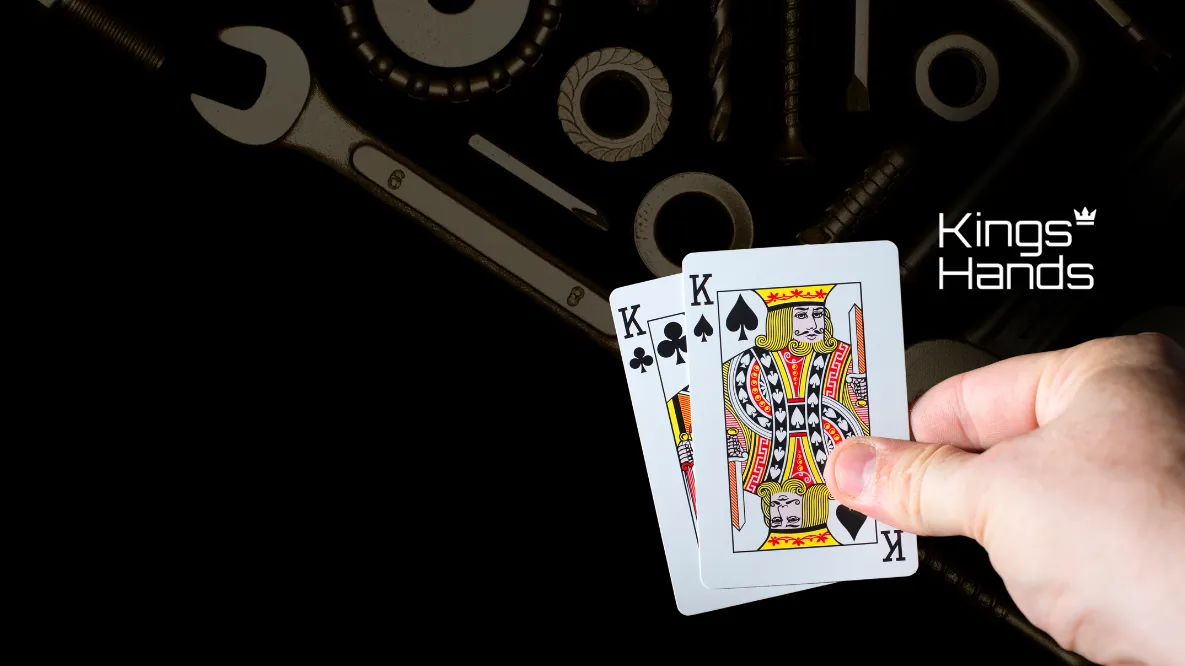In our first article on poker math, we looked at how you can calculate the probability of certain events happening at the poker table, such as making your flush on the turn or making a pair by the river. While it’s important to know these probabilities, they’re not useful on their own; they need to be paired with the subject of our second article – pot odds.
In this article, we’ll take a look at why you should combine the two while you’re playing, how to do it, as well as a few quiz questions to make sure that you completely understand the topic.
Why Should We Combine Pot Odds And Poker Probabilities?
So, why exactly should we bother combining pot odds and poker probabilities? What benefit do we get from adding more complexity to our game?
When we learned about pot odds, we learned that you can determine how much equity you need to profitably continue in a situation. However, without a way to determine how much equity we have, we’re essentially guessing whether or not a call is profitable!
Similarly, when we learned about poker probabilities, we learned how to determine the likelihood that we would win based on our hand and the remaining cards in the deck. However, without pot odds, we wouldn’t know what to do with this information, and we’d be guessing whether we have the right price based on how likely we are to win.
When you combine probabilities with pot odds, you can determine whether or not a call is profitable, allowing you to make an informed decision that has a material impact on your win rate in the game. Until you learn and master these mathematical concepts, you’re essentially flying blind; unable to determine whether or not you’re making a good decision.
How Do We Combine Pot Odds And Poker Probabilities?
While it may sound complicated at first, combining these two poker math concepts is simple. After a couple of tries, you’ll soon get the hang of it, and it won’t be long before you’re using it in your own poker game! Let’s take a look at an example to see what we need to do.
We’re on the flop with 6h5h in a $1/$2 cash game. The board reads AhTh4d, giving us a flush draw. Our opponent has bet $5 into a $20 pot. How can we combine poker probability and pot odds to determine whether or not a call would be profitable?
First, we need to determine how likely we are to make the best hand. Given that we’re on the flop, and we don’t know if our opponent will bet on the turn, we should calculate our likelihood of making our flush on the turn.
If you remember from our previous articles, there’s an easy way to work this out. We simply take the number of outs we have and multiply it by two. We have nine outs to make our flush, so we multiply 9 by 2, which gives us 18. This means we have a roughly 18% chance of making our flush on the turn.
So, now we know how likely we are to make the best hand, let’s find out if we’re getting the right odds to call. Our opponent bet $5 into a $20 pot ($25 after we factor in our opponent’s bet), giving us pot odds of 5:1. For those of you who missed the pot odds article, the formula to calculate our minimum required equity is as follows:
Minimum Equity = (Size of call / (Size of pot + Size of call)) * 100
Let’s plug the numbers in from our example into this equation, and let’s see what we’ve got.
Minimum Equity = ($5 / ($25 + $5)) * 100
Minimum Equity = ($5 / $30) * 100
Minimum Equity = 0.1667 * 100 = 16.67%
Therefore, we can see that we need at least 16.67% equity for our call to be profitable. We calculated at the start of this exercise that we’re going to make the best hand 18% of the time, which means we have the required equity to make a profitable call.
Pot Odds And Poker Probabilities In Action
Let’s take a look at this concept in action in a real-life poker hand. This hand took place at Hustler Casino Live, where Mariano and Alex faced off against each other in a 5bet pot with some pretty wild holdings. Alex holds Jd9d, whereas Mariano has KsTs. The two players see a flop of 8d8s5s, giving Mariano a flush draw and two overcards. He checks over to Alex, who makes a bet of $7,400 into a $24,000 pot. The question for Mariano is, “Is this a profitable call?”
Let’s break it down. Mariano has 9 outs to what’s almost certainly the best hand. He knows that he has a roughly 18% chance of making the best hand on the turn, so now he needs to determine what his pot odds are.
Alex bet $7,400 into a $24,000 pot, giving Mariano pot odds of around 4.25:1. Knowing this information, Mariano can perform the calculation to determine the minimum amount of equity he needs to make a profitable call.
Remember, when doing this equation, you can use the pot odds numbers rather than the actual bet amounts – it’s much easier doing this with lower numbers than it is with higher ones! So, let’s take a look at what the equation says.
Minimum Equity = (1 / (4.25 + 1)) * 100
Minimum Equity = (1 / 5.25) * 100
Minimum Equity = 0.1904 * 100 = 19.04%
As you can see, Mariano needs at least 19.04% equity to continue, but he’s only going to make the best hand 18% of the time. However, given how aggressive Alex has been playing, he may think that he makes the best hand if he hits one of his overcards. So, if Mariano thinks he has 12 or 15 outs rather than just 9, he would make the best hand 24%/30% of the time on the turn, making it a profitable call.
In the hand, Mariano makes the call on the flop, but didn’t make his flush; he ended up folding to further aggression on the turn.
Pot Odds And Poker Probabilities Test
Now that we’ve explained how to combine pot odds and poker probabilities in a hand, let’s put your newfound skills to the test. Answer the questions below; you can find the answers at the bottom of the page.
Question 1
You have a flush draw on the turn and your opponent has bet $100 into a $100 pot. Do you have the right pot odds to continue profitably?
Question 2
You have an open-ended straight draw on the flop and your opponent has bet $40 into a $200 pot. Do you have the right pot odds to continue profitably?
Question 3
You have an open-ended straight draw with an overcard on the turn and your opponent has bet $40 into a $55 pot. Do you have the right pot odds to continue profitably?
Summary
Poker probabilities and pot odds are two aspects of poker math that are incomplete without each other. Each one only gives you half of the picture, but when you combine them, you get a full understanding of the situation you’re in. Using these two concepts together removes the guesswork from your poker game and allows you to make more insightful decisions based on math rather than gut instinct.
Remember, practice makes perfect, so make sure you repeat these exercises until you know it like the back of your hand!
Answers:
Question 1 – You have an 18% chance to make your flush by the river and you’re getting pot odds of 1:1, meaning that you have a minimum equity requirement of 33%. This means you do not have the right odds to make a profitable call.
Question 2 – You have a 16% chance of making the best hand on the turn, and you’re getting pot odds of 6:1, meaning that you have a minimum equity requirement of 14.28%. This means you do have the right odds to make a profitable call.
Question 3 – You have a 22% chance of making the best hand by the river, and you’re getting pot odds of 2.375:1, meaning that you have a minimum equity requirement of 29.62%. This means you do not have the right odds to make a profitable call.





















